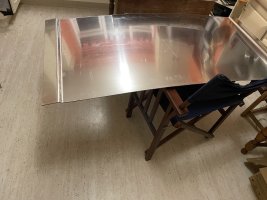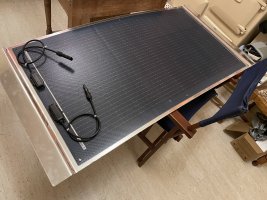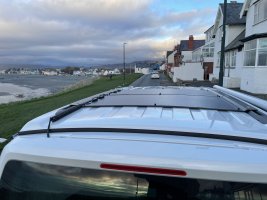B
Benham
Super. Thank you.The panels come supplied with foam already stuck to the bottom of the fixing frame
Super. Thank you.The panels come supplied with foam already stuck to the bottom of the fixing frame
Not sure if foam between panel and roof is a good idea because panels do not operate the best if overheated. A little bit of air circulation is a good thing. That what I have. Black roof, black panel but not in contact with each other except for mounting on the edges.
The California has a ribbed roof. The foam sits on the high ribs, plenty of air flow. My 100w panel lasted 9 yrs before failing.Not sure if foam between panel and roof is a good idea because panels do not operate the best if overheated. A little bit of air circulation is a good thing. That what I have. Black roof, black panel but not in contact with each other except for mounting on the edges.
Somewhat late reply apologies!Hi - how have you wired the EF pack in to your solar charging set up?
So far, I’ve concluded a 12V female ciggie adaptor wired to the Victron load, in turn plugged into the EF with the 12V adaptor.
I’m sure there are other ways and interested to hear how others are setting it up.
Interested to read that in 12 years of ownership you never plug into the EHU at home. Question is that 12 years owning the same van if so how have you replaced the LBs? Also how many months at a time will your van go unconnected to a EHU? The reason I ask is that my understanding the reason for plugging into a EHU is to charge the LBs and EB to 100% state of charge (SoC) given the smart alternator is purposely designed to go to 80% SoC. Note: the overhead display for the LBs often report 100% SoC but it’s a 100% of 80% SoC. Taking AGM batteries to a true 100% SoC periodically extends their service life. Hence my interest if not done have yours lasted 12 years?I occasionally read stuff about solar panels and think, should we get them? I like the idea of those overland, go-anywhere, self-sufficient vans. BUT...
...in twelve years of Cali ownership, we almost never get a hook-up (unless it's included), have never plugged in at home (not feasible anyway), and have never had a problem managing on the leisure battery.
Our travelling style is touring - we rarely stay anywhere more than a couple of days, so the battery recharges sufficiently while driving.
We run the fridge, charge phones, & have the lights on in the evening. The only time we absolutely needed a hook-up was during a week sitting on a hot Spanish campsite, to keep the fridge running. But I managed five days in Norfolk on the leisure battery.
All-in-all, I don't really understand why lots of people seem to get a hook-up every time - what are they using it for?
I bought from Roger and paid him a small installation charge - he knows all the. ooks and crannies and how to lay the cables and equipment out! I agree the number of panels is dependent upon season and usage plus static time. My one panel is good to nearly double Ah capacity in spring and summer! Roger’s panels screw on to the roof rails so no drilling etc. Also you can remove or add later! With hindsight, I would have added the ‘chargeAll depends how you use the van.
Summer - 1 panel will do.
Spring and or Autumn- 2 panels
All year round - 3 panels.
Roger Donahugh is a forum member and owns this company. If you can wire a plug then you can fit this system
Solar Panels for VW California and Mercedes Marco Polo Camper Vans
DIY easy to install Solar panel kits for VW California / Transporter and Mercedes Marco Polo camper vans. Zero drilling or gluing.solarcampersolutions.co.uk
That would work fine on your T6 as the cig lighters then were powered by the starter. At some point in the 6.1 life they started moving across to the leisures and all mine are powered by the leisure - so you would would just end up with a charge loop.I bought from Roger and paid him a small installation charge - he knows all the. ooks and crannies and how to lay the cables and equipment out! I agree the number of panels is dependent upon season and usage plus static time. My one panel is good to nearly double Ah capacity in spring and summer! Roger’s panels screw on to the roof rails so no drilling etc. Also you can remove or add later! With hindsight, I would have added the ‘charge
engine battery’ to I park on the street (so use a small CTEK (motorbike) charger from leisure 240V inverter across to dashboard cig lighter to keep engine battery charged in winter or lay up times …. you may not need either option above, as I believe (ok to be corrected) that on hookup - there is a very small trickle charge to the engine battery ….
I never knew that! But the extra charge button (what ever its called) on the panel does take them to 100 SoC for real?Note: the overhead display for the LBs often report 100% SoC but it’s a 100% of 80% SoC. Taking AGM batteries to a true 100% SoC periodically extends their service life. Hence my interest if not done have yours lasted 12 years?
Nice! Can I ask what controller you have please? and how it is wired?My solar still working fine and never had to plug in. Keeps batteries (inc engine battery) topped up all the time. Superb set up and mine is a single panel.
To do leisure and starter the Epever Duoracer is the one.Nice! Can I ask what controller you have please? and how it is wired?
We've never plugged our van in at home in six years (not an option), and almost never have a hook up (only in winter, if it's included). The leisure battery seems fine & hasn't ever been changed.Interested to read that in 12 years of ownership you never plug into the EHU at home. Question is that 12 years owning the same van if so how have you replaced the LBs? Also how many months at a time will your van go unconnected to a EHU? The reason I ask is that my understanding the reason for plugging into a EHU is to charge the LBs and EB to 100% state of charge (SoC) given the smart alternator is purposely designed to go to 80% SoC. Note: the overhead display for the LBs often report 100% SoC but it’s a 100% of 80% SoC. Taking AGM batteries to a true 100% SoC periodically extends their service life. Hence my interest if not done have yours lasted 12 years?
Actually we've had two vans over 12.5 years. The first (2008 T5) had been standing unused for a few years so we had a new leisure battery almost immediately, but then it was fine for the next five years; the present van (2026 T6) we've had for six years with the same leisure battery. This lasts us four or five days with no hook-up.We've never plugged our van in at home in six years (not an option), and almost never have a hook up (only in winter, if it's included). The leisure battery seems fine & hasn't ever been changed.
Hi, do you mind saying who supplied purpose built ally sheets please, LukeHi Jim,
I think a couple of 100 w I fitted on my Cali have proved to be a great asset.
They were really useful with the agm’s and since upgrade to Lithium, they have been invaluable. I have front and rear dash cams always on 24/7 whenever it’s not in my garage for piece of mind.
I mounted my panels on two purpose built ally sheets which hug the contour of the roof so no noise or effect on mpg. Up to now, no noise or issues whatsoever.
From experience I have found that good panels along with a good controller can deliver efficiency well over the 95%.
As someone mentioned earlier it depends on your use. If good weather they work well, even on duller days there is output. I found not enough charge into AGMs to use without hookup for days on end, but enough to keep the batteries topped for a few extra days when static.
View attachment 125536
Hi Luke,Hi, do you mind saying who supplied purpose built ally sheets please, Luke



Connect the +tve, red, wire from MPPT output to +tve, red, terminal of a leisure battery and the -tve, black, lead to a chassis earth point.Let me clarify a little.
I am new to California and am preparing to travel around France and Spain for 50 days this summer.
I bought an ANKER SOLIX PS100 100 W solar panel and an Anker SOLIX C300 Portable Power Station as a backup.
But after reading the forum, I realized that I could try placing the solar panel directly outside and connecting the SmartSolar MPPT 75/10 or 75/15 via MC4 to XT-60 wires.
However, I am still unsure where to connect the batteries themselves and how this might affect the standard behavior of the car's built-in battery charging system.
1 - They are in parallel, so connect to one, you connect to both. Usually the rear. But you can connect to the front if you like.Thank you for your advice.
Please clarify:
do I need to connect two batteries to the MPPT?
The front and rear batteries?
Does that mean I need to run two red positive wires for each battery?
And two negative wires?
- For the front battery, connect to the car body.
- for the rear battery, connect to the negative terminal.
Have I understood correctly?
Thank you very much.If you use search and hunt out my guide it shoes you how to connect the wires and where.
1 - They are in parallel, so connect to one, you connect to both. Usually the rear. But you can connect to the front if you like.
2 - No, front or rear
3 - No, just one, the other is for chassis earth
4.- No, just one, see above
5 - Connect the - to any part of the car you like, but the shoe under the rear battery is simplest
6 - Positive, with fuse.
If you use search and hunt out my guide it shoes you how to connect the wires and where.

The VW California Club is the worlds largest resource for all owners and enthusiasts of VW California campervans.

